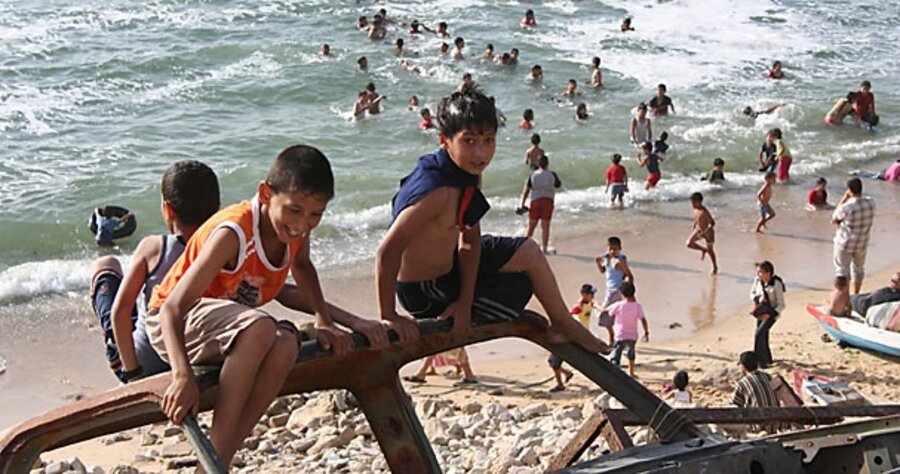Israel-Hamas standoff deepens water woes
Loading...
| AL-SHATI REFUGEE CAMP, The Gaza Strip
Five hundred yards south from where hundreds of children play in the water next to this refugee camp, a pipe spills 20 million liters of raw sewage into the Mediterranean Sea each day.
Between 105 and 120 million liters of sewage are generated daily in Gaza. Of that, only 20 million liters are fully treated, while another 40 million liters are partially treated. The rest flows raw into the sea, storm drains, and a massive landfill north of Gaza City, which spans 4.3 million square feet. The resulting pollution has sullied not only the seawater, but also the aquifer below Gaza, causing a severe shortage of potable water and putting the population at risk for a range of illnesses.
Untreated water is by no means the only pollutant in Gaza. “If there is a stronger word than catastrophe, I would use that word,” says Nader Al Khateeb, the Palestinian director of Friends of the Earth Middle East, an environmental group working in Israel, Jordan, and the Palestinian territories, while describing the overall environmental situation in the Gaza Strip.
Much of this environmental deterioration can be attributed to Gaza’s dilapidated water and sewage infrastructure, which has been further undermined by attacks and fuel blockades resulting from the standoff between Israel and the Hamas government. While the recent ceasefire has provided an opportunity for work on damaged facilities to resume, there’s mounting concern that Israeli water supplies are vulnerable to cross-border contamination.
According to the preliminary findings of a study conducted in May and June by the World Health Organization (WHO), seven of 30 seawater areas sampled in Gaza are now contaminated with either human or animal feces, or both. In the contaminated areas, tests registered levels of bacteria two to five times greater than the amount deemed safe, says Mahmoud Daher, WHO’s national health officer for Gaza.
Due to sewage seeping into the ground, the aquifer beneath Gaza, which provides water for drinking and washing, is now so polluted with nitrates that only 10 percent currently meets WHO standards for safety, adds Monther Shoblak, the director of the World Bank-funded Gaza Emergency Water Project.
“If I would use WHO standards to supply the people here with water, no one would drink,” says Mr. Shoblak.
Gaza’s water problems stem from the territory’s dilapidated water and waste infrastructure. According to the United Nations, 60 percent of
Gazans have access to water in their homes every other day for four to six hours while 15 percent have access only once a week, for the same amount of time.
The lack of running water has motivated Gazans to dig at least 4,000 illegal wells in the past two years, adds Shoblak. The illegal wells, dug directly into the aquifer, have drained it at some places below the water table of the sea, leaving the aquifer salinated and unusable even for washing and cooking. Einav Shimron Grinboim, a spokeswoman for Israel’s Health Ministry, said in a statement that Israel is “worried concerning this problematic situation.”
Pollution was severely exacerbated by the Israeli bombing of Gaza’s power plant two years ago. The siege laid on Gaza for the past year, during which fuel imports were limited, also prevented facilities maintenance.
The Hamas government says the lack of power and fuel prevents the operation of the waste water treatment facilities at full capacity. But Israel counters that there is sufficient power and fuel and that Hamas simply has higher priorities than protecting the health of its citizens.
Both Israeli and Palestinian authorities say that during the siege, the raw metals, plastics, and spare parts needed to maintain Gaza’s sewage and plumbing infrastructure and waste-water treatment centers were prohibited from entering Gaza due to Israeli concerns that they would be used to manufacture rockets. Three additional treatment centers, funded by international donors, were not developed for the same reason.
Since the beginning of the cease-fire on June 19, however, materials for the facilities have started arriving in Gaza. This has led to decreased levels of contamination of the partially treated sewage flowing into the sea, from a biological oxygen demand level of between 70 and 100 milligrams from January to June to a current level of between 60 and 70 milligrams. WHO standards call for a level of between 35 to 50 milligrams.
Despite minor improvements, environmentalists in Israel are worried that the contamination of shared sea and underground water systems means that Israelis may soon have water pollution problems of their own. So far, tests on the groundwater and seawater in southern Israel have not revealed any significant pollution. But Gidon Bromberg, the Israeli director of Friends of the Earth Middle East, says it is only a matter of time.
“Sewage knows no borders,” he adds. “We see both the Palestinians and the Israelis shooting themselves in the foot.”





